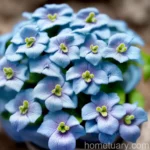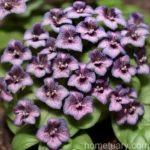Lungwort (Pulmonaria ‘Irish Spring’ GAELIC SPRING): A Comprehensive Guide
Introduction
Pulmonaria ‘Irish Spring’, also known as Gaelic Spring, is a delightful perennial plant sought after for its vibrant flowers and unique foliage. This beautiful lungwort variety is a popular choice for gardeners looking to add color and interest to their gardens. In this comprehensive guide, we will explore the cultivation, uses, care tips, and fascinating facts about this charming plant.

What is Lungwort (Pulmonaria ‘Irish Spring’ GAELIC SPRING)?
Lungwort (Pulmonaria ‘Irish Spring’ GAELIC SPRING) is a herbaceous perennial plant that belongs to the Boraginaceae family. It is a cultivar of the Pulmonaria genus and is known for its attractive, lance-shaped leaves and clusters of vivid blue flowers. This plant is native to Europe and is valued for its ornamental qualities, making it a popular choice for gardens and landscaping projects.
Key Takeaways
Before we delve deeper into the specific aspects of lungwort (Pulmonaria ‘Irish Spring’ GAELIC SPRING), let’s highlight some key takeaways about this plant:
- Pulmonaria ‘Irish Spring’ GAELIC SPRING is a variety of lungwort appreciated for its striking blue flowers and attractive foliage.
- This plant is well-suited to shady areas and is often cultivated for its ornamental value in woodland gardens and shaded borders.
- Lungwort (Pulmonaria ‘Irish Spring’ GAELIC SPRING) is relatively low-maintenance and can contribute to the overall aesthetic appeal of a garden.
Now that we have a general overview of lungwort (Pulmonaria ‘Irish Spring’ GAELIC SPRING), let’s explore its culture, uses, and care requirements in detail.
Culture
Water
Lungwort plants prefer moist, well-draining soil. While they have some tolerance for dry conditions, it is essential to provide regular watering, especially during dry periods. When watering, aim to keep the soil consistently moist but not waterlogged. Avoid overhead watering to prevent the onset of foliar diseases.
Sunlight
Pulmonaria ‘Irish Spring’ GAELIC SPRING thrives in partial to full shade. In their natural habitat, lungwort plants are often found growing beneath trees or in woodland settings where dappled sunlight filters through the canopy. When cultivating this plant, choose a location with dappled shade or partial shade to ensure optimal growth and flowering.
Fertilizer
Applying a balanced, slow-release fertilizer in spring can support the growth and blooming of lungwort plants. Look for a fertilizer with a formulation such as 10-10-10 or similar, and apply it according to the manufacturer’s instructions. Avoid over-fertilizing, as lungwort plants are not heavy feeders and excessive nutrients can lead to lush foliage at the expense of flowers.
Soil
Lungwort plants thrive in humus-rich, slightly acidic to neutral soil. They are adaptable to various soil types, including loamy and sandy soils, as long as the soil is well-draining. Amending the soil with organic matter such as compost or peat moss can improve its moisture retention and fertility, creating an ideal growing environment for Pulmonaria ‘Irish Spring’ GAELIC SPRING.
Uses
Ornamental Value
One of the primary uses of Pulmonaria ‘Irish Spring’ GAELIC SPRING is its contribution to the ornamental appeal of gardens and landscapes. The vibrant blue flowers and speckled foliage provide visual interest and can complement other shade-loving plants in a garden bed or border.
Wildlife Garden
Lungwort plants are known to attract pollinators, particularly early-emerging bees, with their nectar-rich flowers. By incorporating Pulmonaria ‘Irish Spring’ GAELIC SPRING into a wildlife-friendly garden, gardeners can support important pollinators and contribute to the biodiversity of their outdoor spaces.
Pruning
Pruning lungwort plants is a simple task that primarily focuses on removing spent flowers and any damaged or yellowing leaves. Deadheading the faded blooms can encourage the plant to produce new flowers and maintain a tidy appearance. Additionally, removing any diseased or discolored foliage can help prevent the spread of diseases and promote the overall health of the plant.
Propagation
Lungwort plants can be propagated through division or by sowing seeds. Division is typically carried out in early spring or early autumn when the plants are not actively flowering. By carefully dividing the root clumps into smaller sections, each containing healthy roots and foliage, gardeners can create new plants to expand their lungwort population or share with fellow gardening enthusiasts.
Container Popularity
Pulmonaria ‘Irish Spring’ GAELIC SPRING can be successfully grown in containers, making it an excellent choice for gardeners with limited space or those looking to create portable displays of vibrant foliage and flowers. When growing lungwort in containers, select a spacious pot with adequate drainage holes and fill it with a high-quality potting mix that matches the plant’s soil preferences.
Common Diseases
Lungwort plants are generally resistant to major diseases, but they can occasionally encounter issues such as powdery mildew, leaf spot, or root rot. Maintaining good air circulation, avoiding overhead watering, and promptly removing any diseased foliage can help prevent the onset and spread of these diseases.
Disease Diagnosis
To diagnose and address potential diseases affecting lungwort plants, gardeners should closely monitor the foliage for any signs of discoloration, spots, or unusual growth. If abnormalities are observed, it is advisable to consult local garden centers, extension services, or plant health specialists who can provide specific guidance on disease diagnosis and management.
Common Pests
While lungwort plants are relatively resistant to pest infestations, they can attract slugs and snails, particularly in moist conditions. To mitigate pest damage, gardeners can employ strategies such as handpicking the pests, setting up physical barriers, or using organic pest control methods to protect their lungwort plants from slug and snail feeding.
Botanist’s Tips
For successful cultivation of Pulmonaria ‘Irish Spring’ GAELIC SPRING and to fully appreciate the beauty of this plant, consider the following botanist’s tips:
- When planting lungwort, ensure that the soil is consistently moist, as dry conditions can lead to stress and reduced flowering.
- Regularly monitor the plant for signs of pests or diseases, as early intervention can prevent issues from escalating and damaging the plant.
- Incorporate lungwort plants into shaded gardens, woodland settings, or mixed perennial borders to capitalize on their ornamental and ecological value.
Fun Facts
As we conclude our exploration of lungwort (Pulmonaria ‘Irish Spring’ GAELIC SPRING), let’s uncover some intriguing fun facts about this charming plant:
- Lungwort plants have been historically used in herbal medicine, with their leaves and flowers believed to possess medicinal properties. However, modern usage for medicinal purposes should be approached with caution and under professional guidance.
- In some regions, Pulmonaria ‘Irish Spring’ GAELIC SPRING is considered a symbol of fidelity and is often associated with love and enduring relationships.
Links to External Resources
For further information about lungwort (Pulmonaria ‘Irish Spring’ GAELIC SPRING) and related topics, consider exploring the following external resources:
- Royal Horticultural Society – Pulmonaria ‘Irish Spring’ GAELIC SPRING
- Missouri Botanical Garden – Pulmonaria cultivation
- The Spruce – Growing and Caring for Lungwort Plants
Conclusion
In this comprehensive guide, we’ve delved into the captivating world of lungwort (Pulmonaria ‘Irish Spring’ GAELIC SPRING), uncovering its cultural significance, practical uses, and essential care tips. Whether you’re an avid gardener or simply intrigued by the beauty of this plant, we hope that this guide has provided valuable insights and inspiration for incorporating Pulmonaria ‘Irish Spring’ GAELIC SPRING into your outdoor spaces. By embracing the unique qualities of this charming plant, gardeners can enhance the aesthetic appeal of their gardens while supporting the ecological balance of their natural surroundings. Here’s to the enduring beauty and allure of lungwort plants, and the joy they bring to gardens far and wide.















